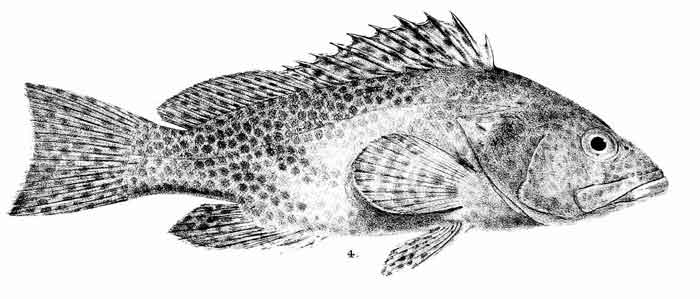Superregnum: Eukaryota
Cladus: Unikonta
Cladus: Opisthokonta
Cladus: Holozoa
Regnum: Animalia
Subregnum: Eumetazoa
Cladus: Bilateria
Cladus: Nephrozoa
Superphylum: Deuterostomia
Phylum: Chordata
Subphylum: Vertebrata
Infraphylum: Gnathostomata
Megaclassis: Osteichthyes
Superclassis/Classis: Actinopterygii
Classis/Subclassis: Actinopteri
Subclassis/Infraclassis: Neopterygii
Infraclassis: Teleostei
Megacohors: Osteoglossocephalai
Supercohors: Clupeocephala
Cohors: Euteleosteomorpha
Subcohors: Neoteleostei
Infracohors: Eurypterygia
Sectio: Ctenosquamata
Subsectio: Acanthomorphata
Divisio/Superordo: Acanthopterygii
Subdivisio: Percomorphaceae
Series: Eupercaria
Ordo: Perciformes
Subordo: Percoidei
Superfamilia: Percoidea
Familia: Serranidae
Subfamilia: Epinephelinae
Genus: Plectropomus
Species: P. areolatus – P. laevis – P. leopardus – P. maculatus – P. oligacanthus – P. pessuliferus – P. punctatus
Name
Plectropomus Oken, 1817
References
Plectropomus – Taxon details on Integrated Taxonomic Information System (ITIS).
Plectropomus species list in FishBase,
Froese, R. & Pauly, D. (eds.) 2024. FishBase. World Wide Web electronic publication, www.fishbase.org, version 02/2024.
Vernacular names

Plectropomus areolatus
Plectropomus, commonly known as the coral groupers, is a genus of marine ray-finned fish, groupers from the subfamily Epinephelinae, part of the family Serranidae, which also includes the anthias and sea basses. They are found in the Indo-Pacific region.
Habitat and biology
The Plectropomus coral groupers are ecologically similar to the species in the genera Cephalolophis and Mycteroperca, the latter being regarded as the Atlantic and eastern Pacific equivalents of the coral groupers. They are large groupers, with some species attaining total lengths of at least 1 metre (3.3 ft), They prefer shallow tropical and subtropical waters where there are coral reefs and are less sedentary than the groupers in the genera Epinephelus and Cephalopholis. They are predatory species, preying largely on fish.[3]
Distribution
Plectropomus coral groupers are confined to the Indo-Pacific region where they are found from the Red Sea and the east coast of Africa as far south as South Africa and east into the Western Pacific Ocean as far as Polynesia, north to Japan and south to Australia.[3]
Utilization
Plectropomus coral groupers are very important to artisanal fisheries wherever they are found and they are caught using hook and line by spear fishing and trapping, however they are a frequent cause of Ciguatera poisoning among consumers of their flesh.[3]
Species
The following eight species are classified within the genus Plectropomus:[4]
| Image | Scientific name | Common Name | Distribution |
|---|---|---|---|
 |
Plectropomus areolatus (Rüppell, 1830) | squaretail coral grouper | Indo-Pacific: Red Sea to the Phoenix Islands and Samoa, north to Ryukyu Islands, south to Australia. |
 |
Plectropomus laevis (Lacepède, 1801) | black-saddled coral grouper | Indo-Pacific, from East Africa (Kenya, Mozambique) to the central and southern Pacific, eastward to the Tuamotu Island, north to the Ryukyu Islands, south to Australia, Indian Ocean and islands of western and central Pacific |
 |
Plectropomus leopardus (Lacepède, 1802) | leopard coral grouper | western Pacific Ocean |
 |
Plectropomus maculatus (Bloch, 1790) | spotted coral grouper | Western Pacific: Thailand, Singapore, Philippines, Indonesia, Papua New Guinea, the Arafura Sea (Ref. 9819), Solomon Islands, and Australia |
 |
Plectropomus oligacanthus (Bleeker, 1854) | highfin coral grouper | Indo-West Pacific: Philippines, Indonesia, New Guinea, northeastern Australia (Cape York to northern Great Barrier Reef) Belau, Truk, Caroline Islands, Marshall Islands, and the Solomon Islands. |
 |
Plectropomus pessuliferus (Fowler, 1904) | roving coral grouper | Indo-Pacific, from the Red Sea to Fiji (Djibouti, Egypt, Eritrea, Indonesia (Bali, Java and Sumatra), Israel, Jordan, Mozambique, Saudi Arabia, Sudan, Tanzania, Tonga, Zanzibar, Maldives, Laccadives, St. Brandon's Shoals, Sri Lanka, Chagos, Nazareth Bank, and Fiji) |
| Plectropomus punctatus (Quoy & Gaimard, 1824) | marbled coral grouper | Western Indian Ocean: Kenya to South Africa, Comoros, Madagascar, Aldabra, Seychelles, Mauritius, St. Brandon's Shoals, Nazareth Bank, and the Chagos Archipelago. Unknown from the Red Sea, Persian Gulf, and the Asian coast from Arabia to India. |
Other authorities recognise Plectropomus marisrubri, which Fishbase treats as a synonym of P. pessuliferus, as a valid species.,[5] while others as treat it as a subspecies of P. pessuliferus, P.p. maristrubri.[3]
References
Eschmeyer, William N.; Fricke, Ron & van der Laan, Richard (eds.). "Plectrpomus". Catalog of Fishes. California Academy of Sciences. Retrieved 30 July 2020.
Eschmeyer, William N.; Fricke, Ron & van der Laan, Richard (eds.). "Genera in the family Epinephelinae". Catalog of Fishes. California Academy of Sciences. Retrieved 30 July 2020.
Heemstra, P.C. & J.E. Randall (1993). FAO Species Catalogue. Vol. 16. Groupers of the world (family Serranidae, subfamily Epinephelinae). An annotated and illustrated catalogue of the grouper, rockcod, hind, coral grouper and lyretail species known to date (PDF). FAO Fish. Synopsis. Vol. 125. FAO, Rome. pp. 285–286. ISBN 92-5-103125-8.
Froese, Rainer and Pauly, Daniel, eds. (2019). Species of Plectropomus in FishBase. December 2019 version.
Eschmeyer, William N.; Fricke, Ron & van der Laan, Richard (eds.). "Species in the genus Plectropomus". Catalog of Fishes. California Academy of Sciences. Retrieved 31 July 2020.
Retrieved from "http://en.wikipedia.org/"
All text is available under the terms of the GNU Free Documentation License

